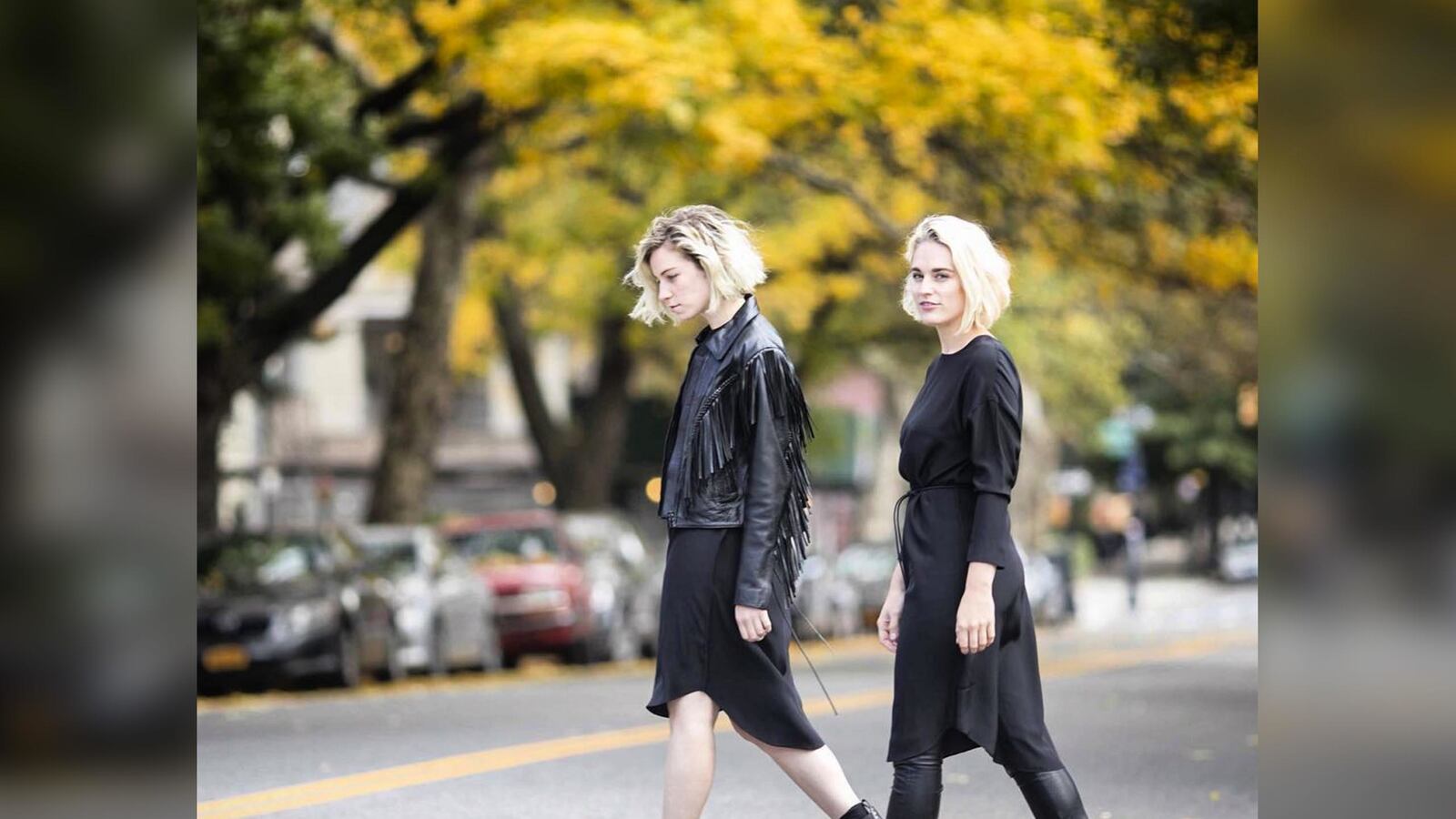It doesn’t take more than a quick glance at Chaya Chanin’s and Simi Polonsky’s ensembles to guess they are fashionistas, the kind that thrive on pairing the designer accessories and hip accents that baffle most normal dressers.
Chanin’s rocking a bronzed leather vest, magenta lipsticks, a small subtle nose stud, and metallic-framed glasses and Polonsky’s paired a feminine blue satin dress with cool white sneakers for a playfully edge look when we meet.
In fact, the sister designers behind The Frock, a line of slip dresses that has earned shout-outs from Vogue to Man Repeller in under a year of existence, almost seem too much like a stereotype of up-and-coming fashion mavens in Brooklyn.
That is until one sees the Crown Heights apartment where Polonsky lives and The Frock operates out of—where a mezuzah, a case containing a piece of Torah scriptures written on parchment, greets me at the door and the picture of the older, bearded Orthodox Jewish man hangs above the couch.
Chanin and Polonsky are beyond stereotypes because they are a combination of two of the most common Brooklynites in 2015: millennial artists and Hasidic Jews.
Perhaps because they blend those two community identities so well, their line of sleek modest dresses is garnering acclaim--not only from the Orthodox Jewish community but the mainstream fashion world as well.
The women, who sell their dresses directly and mostly through their website, estimate that non-Orthodox women have grown from 20 to 40 percent of their sales, with orders requested from as far away as France, England, and Japan.
Chanin, 30, and Polonsky, 29, are specifically Hasidic, a sect of Orthodox Judaism. Their passion for finding stylish ways to dress modestly began in their childhood in Sydney’s Coogee Beach, which they describe as a “cool, chic beautiful neighborhood.”
From the way they talk about the sunny weather, the Bondi markets, and the great coffee shops, it’s easy to forget they were raised in a family of seven children headed by an Orthodox rabbi father and a Judaics teacher mother.
It went without saying that the two sisters would adhere to tznius (modest in Yiddish) clothing regulations. The tznius rules aren’t precise, but there are general guidelines. “We don’t wear pants. You cover your knees. You don’t have revealing, plunging necklines,” Polonsky explains. “A lot of people say you cover the elbows,” she adds.
The two women say they were always aware that their clothes didn’t mesh with the beach culture, which was all the more palpable considering how fashion obsessed they were from a young age.
They describe spending their Shabbat afternoons reading through Vogue, loving the clothes but also realizing the disparity with their own wardrobes—let alone their neighborhood.
“We lived literally around the corner from the beach. A lot of skin was exposed,” recalls Polonsky. “Every Saturday, we’d get dressed [for synagogue] and be wearing this covered, long-sleeved clothing. We stood out for looking different.
"From a very young age, I was very stubborn and I never wanted to stick out for looking different in a bad way. I didn’t mind being modest, but I wanted to mesh in and look great.”
That desire to not stand apart but hold their own among the stylish throngs of Sydney is ultimately what forced the women to get creative and start making high fashion work within the confines of Jewish modest dressing.
They developed a reputation within their religious Jewish community and started a small business as teens styling other female congregants.
“The whole point of our mission—and even what we do today—was for an Orthodox woman to be able to walk down the street and for someone to go ‘Oh my god. She looks incredible. She could be snapped up in Fashion Week.’ And then they’d look at her again and wouldn’t even realize that she’s modest,” Polonsky says.
But they wouldn’t come to execute that mission in full force until they came to the States as married women—Chanin to Brooklyn, where her husband practices as an addiction recovery coach, and Polonsky to Cleveland, where her husband was a graduate student in psychology.
Both sisters were working in retail. Chanin was at a watch boutique, while Polonsky styled shoppers at the now-closed Anne Van H Boutique.
In 2010, Polonsky found herself itching to break out into her own business with her sister. “I dressed these women, not even religious women, and I would sometimes call Chaya and say, ‘I could do this myself.’”
Chanin simply put it, “We were not feeling passionate about what we did.”
The two decided to start their own clothing business, but not their own line—yet. The sisters started off in consignment with The Frock Swap, which offered designer items that specifically fit with the fashion needs of Orthodox women.
That was 2010 when Chanin was very pregnant with her second child. On the day we meet in Polonsky’s apartment, she is the sister who is now weeks away from giving birth to her second child.
After curating a collection from around 20 of their friends, their first consignment sale was “an overnight success,” says Polonsky. “There was so much hype because there was nothing of the sort.”
While Polonsky formally trained in fashion design at the Whitehouse Institute for Design for two years, the sisters only decided to start their own line when they realized a tznius-acceptable slip dress was needed to help Orthodox women wear the stylish accessories they wanted.
“There were so many women missing essential pieces in their wardrobes," explains Polonsky. "We would dress people and they would have an amazing blazer. We’d say, ‘Just put a cute dress underneath.’ They’d say ‘I can’t find a dress that covers my knees, that’s high enough, that has sleeves so if I take off the jacket, I can just wear it.’”
“Those frustrations from women we were dealing with in many orthodox communities were the inspiration. We would take that feedback. That’s what the people are missing.”
The Frock now has three dress designs: the Signature Slip ($168), the Frock Heaven ($158), and the Silky T ($148).
The first dress came out in January of this year, and the sisters said that initial run sold out within 10 days. Their second run in March sold out within two weeks.
But transitioning from stylers to designers was not seamless (pun intended). Chanin and Polonsky remember how they imperfectly graded—a term for creating different sizes—one design, ultimately spending tens of thousands of dollars to make hundreds of wrongly sized dresses.
Other errors along production have been more fortuitous—even a sign from the Divine, they say.
When I compliment Polonsky on the beautiful shade of blue her dress is—it’s a blend of navy and aqua—she tells me that the color was actually a mishap.
“We once ordered a deep navy. God had a plan, and He said, ‘You’re not getting that darker navy. You’re getting this one.’ Once they sent it to us, we could have sent it back, but we were on a deadline. We decided to go for it,” she says. “It’s been our best seller.”
“This is going to sound so corny, but it is a lot about keeping the faith. No matter what mistakes we’ve made, it’s meant to be this way. It’s going to turn out for the best.”
However, lest one gets the wrong impression that Chanin and Polonsky are sanctimonious holy rollers, the sisters say they are actually driven by the desire to defy the stereotypes of religious women through fashion.
The two women specifically pick a bone with, what they consider is, a false perception that Orthodox women as deeply oppressed—and that the oppression manifests itself in drab, frumpy, unattractive clothing.
“We feel women can do anything, but there are so many people who say ‘Oh, Orthodox women are so oppressed,’” Polonsky says.
To push against that image, the two women have taken steps to play with the boundaries of tznius dressing in their personal lives—even when it doesn’t directly involve The Frock.
Polonsky and Chanin still remember the stir they caused in their circle of Orthodox Jewish women when they wore pants for the first time in public—and even Instagrammed the risque ensemble (the sisters take great pride in Instagramming many of their ensembles to more than 10,000 followers).
While under tznius regulations women are not supposed to wear pants alone, the duo decided to try pants under a dress to create wiggle room.
The outfit Polonsky wore that sent tongues wagging were baggy black-and-white pants paired with a black dress over it. Chanin wore a pair of her husband’s jeans a week later to even more uproar.
“They were a little baggy, and I wore them with pointy stilettos and an over-sized black dress,” remembers Chanin. “That was shocking because jeans are even more shocking than pants."
The reactions weren’t negative, as much as stunned. “I got phone calls from my friends, saying ‘I swear, I’m never going to do that.’ They really thought it was crossing a line,” says Polonsky, adding with a note of satisfaction that “all those people who said that are now wearing pants because it has become so normal.”
“I think we’ve pioneered an understanding of modesty that’s not necessarily in the black-and-white rules. Five years ago, women only wore dresses and skirts,” says Chanin. “We’re teaching people who are interested in modesty in general that there’s no one way to be modest. There are so many ways you can play with it.”
They are not the only Orthodox women making a name for themselves in the mainstream fashion sphere.
This month, Vogue.com cited Chanin and Polonsky when it noted that Rag & Bone’s Fall 2015 runway featured slip dress layering that echoed the stylish tznius flair of the Orthodox world.
That same post also cited fashion blogger Adi Heyman, whose site devoted to runway, high-end, hardcore designer fashion for modest-dressing Orthodox women, Faboogie, earned her a New York Times profile.
I ask Chanin and Polonsky if they feel it’s a special moment for Orthodox women in fashion.
“I don’t think it’s a moment,” says Polonsky. “I feel it’s been a slow buildup. The fashion world was changing, introducing more modest looks to the runways. Then, modest women in general were saying in the past few years, ‘Hey, I want to be fashionable, too.’”
Chanin also credits the fashion shift to larger changes in her Orthodox community. “Our mom when she was our age didn’t have such opportunities. It was ‘Be a mom’ or break the glass ceiling and become an entrepreneur,” she says.
“We’re realizing we can have the best of both worlds. It’s about balance. It’s about pursuing your dreams. People used to think they couldn’t venture into another track because they thought it was oppositional,” says Polonsky.
The women see dressing stylishly as a way to prove you can have both full religious and secular lives. It’s a way to “show the world you can be proud of who you are as a modest dresser. You don’t have to feel like you’re being shoved in a box,” says Polonsky. “It’s 2015, it’s about time the world woke up and saw that an Orthodox woman can be beautiful and stylish and sexy and fashionable and carry herself with pride and dignity.”
Did she say “sexy”?
“You can do sexy in a modest way. Sexy doesn’t have to mean provocative. Sexy can also mean confident,” she explains.
If anyone can prove that, it’s the sisters behind The Frock.






